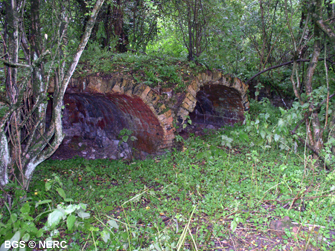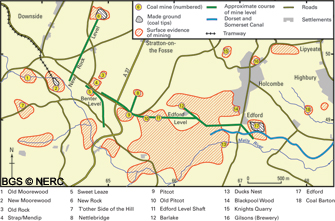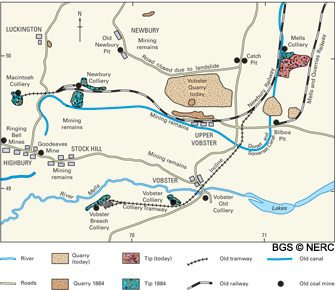
Minerals and mines
Introduction | History
of lead mining | History
of zinc mining | Lead
ore & mines
Zinc ore & mines | Iron
ore, ochre & mines | Coal mining
Coal mining - collieries
Newbury Colliery
Newbury colliery opened in 1799 and was worked until 1927. The coal produced was good quality and was used to make coke for Westbury iron works. The site of Newbury Colliery is now an industrial area, but the winding and pumping engine houses still stand, as do the colliery offices. Coal waste can still be seen in the pathways around the edge of the site. The Newbury collieries were connected by rail to the broad gauge GWR Frome to Radstock line. Opened about 1857, the remains of this rail link can still be seen running between Newbury and Upper Vobster.
Vobster Collieries

At Vobster Colliery, a few remains including the spoil tip, store house and the old ventilation shaft can still be seen. Just to the east is the site of Vobster Old Colliery but nothing remains here except an old spoil heap. The opening of the Newbury Railway stimulated the development of Vobster Breach Colliery nearby, during the early 1860s. A shaft was sunk to link with a branch of Vobster Colliery. By the mid-1860s two banks of coking ovens had been constructed at the site. However, increased competition and a downturn in the coking trade led to economic difficulties and mining had ceased by 1884. Vobster Breach Colliery is now very overgrown. Most of the mine buildings were grouped around an infilled shaft in the centre of the site. The remains of two banks of coking ovens can still be seen but most have now collapsed, although approximately 12 remain intact.
Mells Colliery
This opened in 1863, but closed in 1881, only to re-open in 1909. It was never very profitable and there were lots of disputes about pay and working conditions before it finally closed in 1943. Some of the buildings and the spoil heap remain, but the latter has been obscured by trees. A narrow gauge tramway was laid to connect the railway with the pits in the Nettlebridge valley to the south. Part of the tramway, which is now followed by a footpath, was up an inclined plane just east of the pub in Vobster.
Moorewood Colliery
Near Upper Benter, the remains of Moorewood Colliery can be seen in the valley floor. Sunk in 1860, the shaft was constructed in the anticipation of a rail link to the Somerset and Dorset Railway. However, this never materialized and the pit experienced problems with flooding, closing in 1873. It was reopened in 1909, when a tramway was built up an incline and along what is now Coal Pit Lane to the railway at Old Down. However, the mine was never really profitable and following flooding in 1931, the mine closed in 1932.
Strap Pit, New Rock Colliery and Mendip Colliery
On the hillside to the north is the site of Strap Pit. Begun in 1863, by 1874 this shaft was sunk to a depth of 560m, the deepest in Somerset. However, as at Moorewood Colliery, the lack of a railhead meant it was never profitable and it closed in 1879. It was reopened in 1953 by the National Coal Board and connected to the nearby New Rock Colliery, where upon it became known as Mendip Colliery, but it too made a loss and was closed by 1969.
More detailed information on coal mining can be found here.
- Home
- Overview maps
- Locality
areas
- Cheddar Gorge
- Charterhouse
- Blackdown
- Burrington Combe
- Shipham & Rowberrow
- Crook Peak & Axbridge
- Banwell to Churchill
- Priddy
- Harptree & Smitham Hill
- Draycott & Westbury-sub-Mendip
- Wookey Hole & Ebbor Gorge
- Wells
- Great Elm & Vallis Vale
- Mells & the Wadbury Valley
- The Vobster area
- The Whatley area
- Torr Works & Asham Wood
- Beacon Hill
- Stoke St Michael & Oakhill
- Holwell & Nunney
- Shepton Mallet & Maesbury
- Gurney Slade & Emborough
- The Nettlebridge valley
- Geology
- Minerals and mines
- Quarrying
- Caves and karst
- Biodiversity
- Detailed site information
- Acknowledgements
- External links
- Search
- Site map

